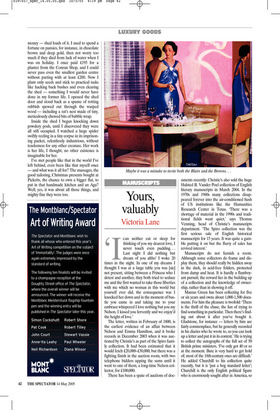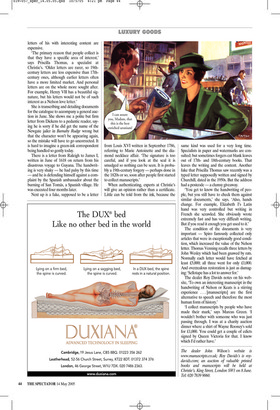Yours, valuably
Victoria Lane
can neither eat or sleep for thinking of you my dearest love, I never touch even pudding... Last night I did nothing but dream of you altho’ I woke 20 times in the night. In one of my dreams I thought I was at a large table you was [sic] not present, sitting between a Princess who I detest and another, they both tried to seduce me and the first wanted to take those liberties with me which no woman in this world but yourself ever did, the consequence was I knocked her down and in the moment of bustle you came in and taking me to your embrace whispered I love nothing but you my Nelson, I kissed you fervently and we enjoy’d the height of love.’ The letter, written in February of 1800, is the earliest evidence of an affair between Nelson and Emma Hamilton, and it broke records in December 2003 when it was auctioned by Christie’s as part of the Spiro family collection. It had been estimated that it would fetch £20,000–£30,000, but there was a fighting finish in the auction room, with two telephone bidders upping the sums until it went to one of them, a long-time Nelson collector, for £100,000.
There has been a spate of auctions of doc
‘I
uments recently: Christie’s also sold the huge Halsted B. Vander Poel collection of English literary manuscripts in March 2004. In the 1970s and 1980s many collections disappeared forever into the air-conditioned hush of US institutions like the Humanities Research Center in Texas. ‘There was a shortage of material in the 1990s and traditional fields went quiet,’ says Thomas Venning, head of Christie’s manuscripts department. ‘The Spiro collection was the first serious sale of English historical manuscripts for 15 years. It was quite a gamble putting it on but the flurry of sales has revived interest.’ Manuscripts do not furnish a room. Although some collectors do frame and display them, they should really be hidden away in the dark, in acid-free folders, protected from damp and heat. It is hardly a flamboyant pursuit; the reward lies in the building up of a collection and the knowledge of ownership, rather than in showing it off.
Marcus Green has been collecting for five or six years and owns about 1,000-1,500 documents. For him the pleasure is twofold: ‘There is the thrill of the chase, the fun of trying to find something in particular. Then there’s finding out about it after you’ve bought it. Gladstone, for instance — letters by him are fairly commonplace, but he generally recorded in his diaries who he wrote to, so you can look up a letter and put it in its context.’ He is trying to collect the autographs of the full set of 50 British prime ministers. ‘I’ve only got 40 or so at the moment. Bute is very hard to get hold of; most of the 18th-century ones are difficult.’ He added Churchill to his collection quite recently, but it is ‘just a bog standard letter’; Churchill is the only English political figure who is enormously sought after in America, so letters of his with interesting content are expensive.
‘The primary reason that people collect is that they have a specific area of interest,’ says Priscilla Thomas, a specialist at Christie’s. ‘Older letters are rarer, so 19thcentury letters are less expensive than 17thcentury ones, although earlier letters often have a more limited market. And personal letters are on the whole more sought after. For example, Henry VII has a beautiful signature, but his letters would not be of such interest as a Nelson love letter.’ She is transcribing and detailing documents for the catalogue to accompany a general auction in June. She shows me a polite but firm letter from Dickens to a pedantic reader, saying he is sorry if he did get the name of the Newgate jailer in Barnaby Rudge wrong but that the character won’t be appearing again, so the mistake will have to go uncorrected. It is hard to imagine a green-ink correspondent being handled so gently today.
There is a letter from Raleigh to James I, written in June of 1618 on return from his disastrous voyage to Guyana. The handwriting is very shaky — he had palsy by this time — and he is defending himself against a complaint by the Spanish ambassador about the burning of San Tomás, a Spanish village. He was executed four months later.
Next up is a fake, supposed to be a letter from Louis XVI written in September 1786, referring to Marie Antoinette and the diamond necklace affair. ‘The signature is too careful, and if you look at the seal it is smudged so nothing can be seen. It is probably a 19th-century forgery — perhaps done in the 1820s or so, soon after people first started to collect manuscripts.’ When authenticating, experts at Christie’s will give an opinion rather than a certificate. Little can be told from the ink, because the same kind was used for a very long time. Specialists in paper and watermarks are consulted; but sometimes forgers cut blank leaves out of 17thand 18th-century books. That leaves the writing and the content. Another fake that Priscilla Thomas saw recently was a typed letter supposedly written and signed by Churchill, dated in the 1950s. But the address had a postcode — a clumsy giveaway.
‘You get to know the handwriting of people, but you still have to check them against similar documents,’ she says. ‘Also, hands change. For example, Elizabeth I’s Latin hand was very controlled but writing in French she scrawled. She obviously wrote extremely fast and has very difficult writing. But if you read it enough you get used to it.’ The condition of the documents is very important — Spiro famously collected only articles that were in exceptionally good condition, which increased the value of the Nelson letter. Thomas Venning recalls three letters by John Wesley which had been gnawed by rats. Normally each letter would have fetched at least £5,000; all three went for only £1,000. And overzealous restoration is just as damaging: ‘Sellotape has a lot to answer for.’ The dealer Roy Davids notes on his website, ‘To own an interesting manuscript in the handwriting of Nelson or Keats is a stirring experience ... [manuscripts] are the first alternative to speech and therefore the most human form of history.’ ‘I collect manuscripts by people who have made their mark,’ says Marcus Green. ‘I wouldn’t bother with someone who was just passing through. I was at a charity auction dinner where a shirt of Wayne Rooney’s sold for £1,000. You could get a couple of edicts signed by Queen Victoria for that. I know which I’d rather have.’



































































 Previous page
Previous page